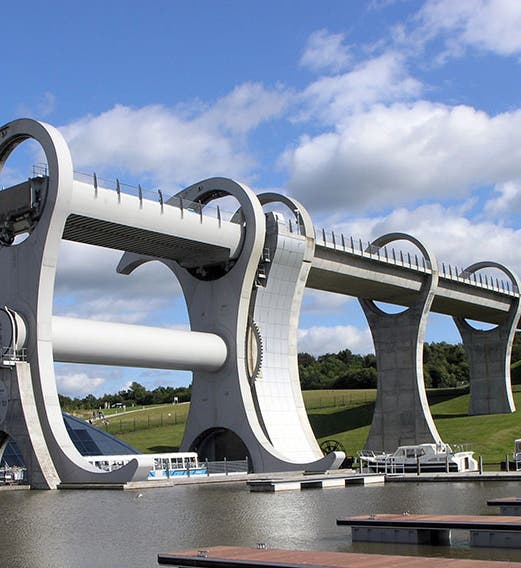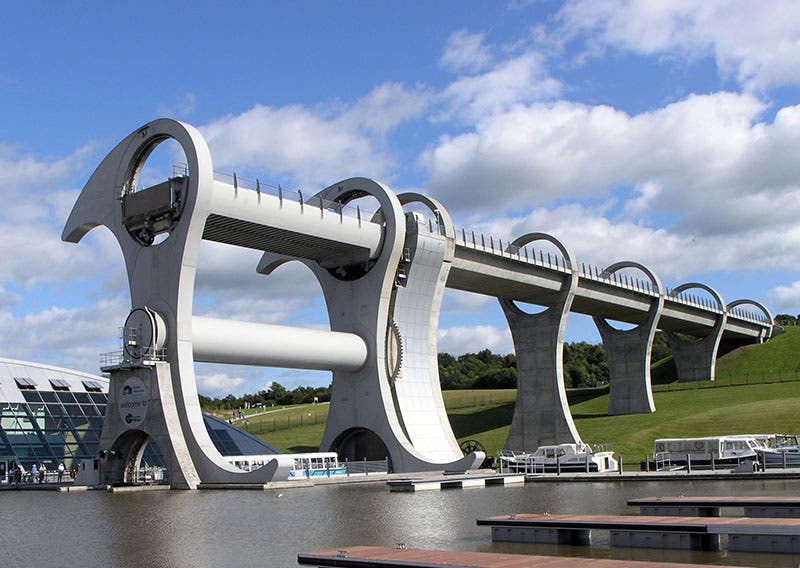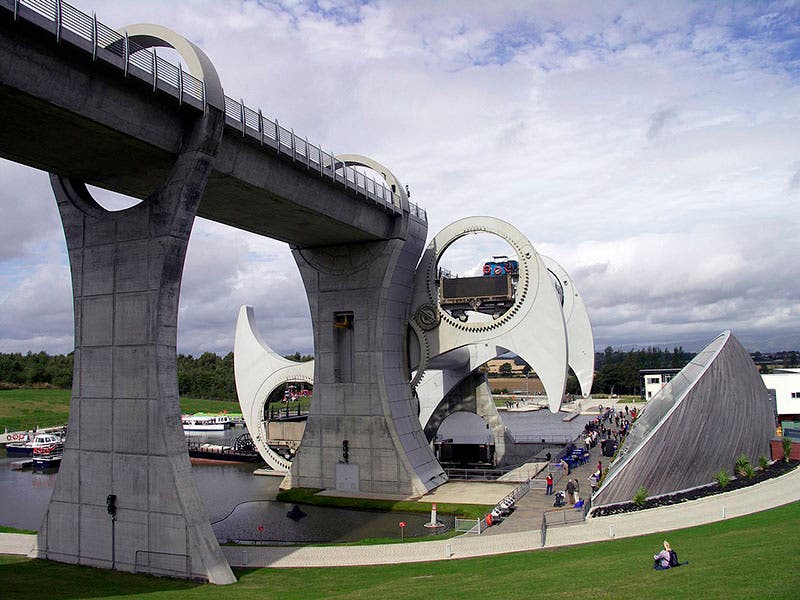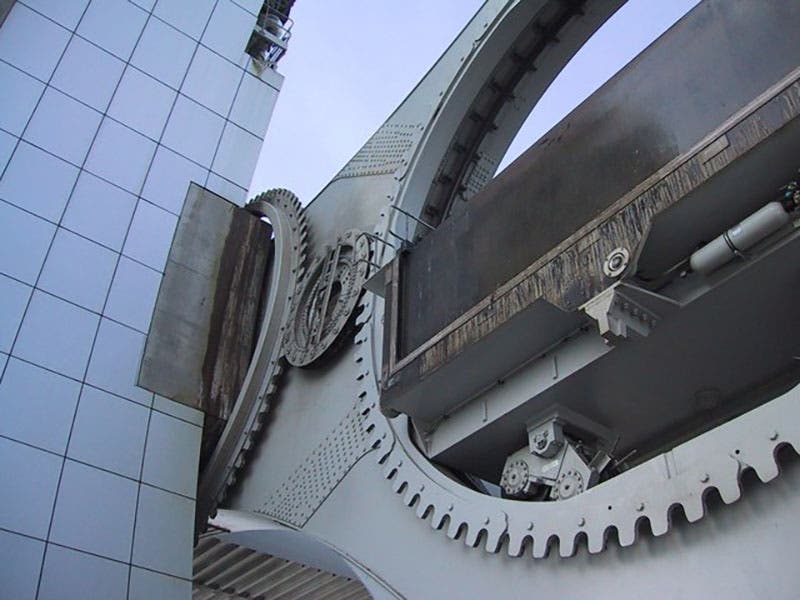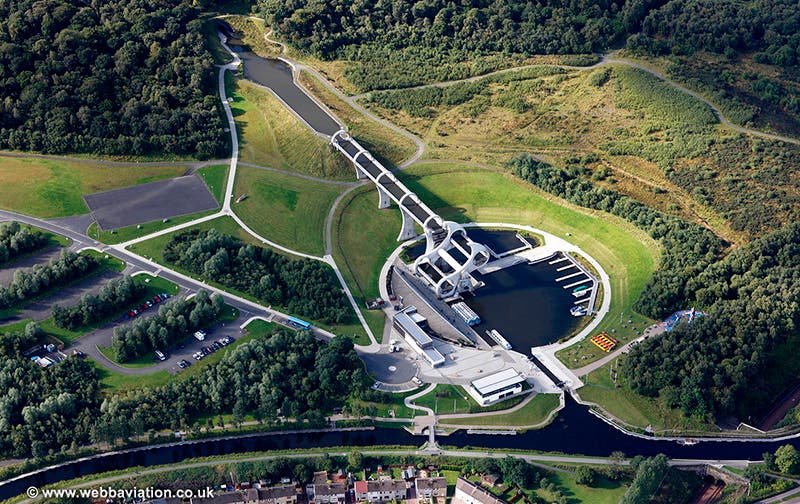Scientist of the Day - The Falkirk Wheel
The Falkirk Wheel, a boat lift in central Scotland, opened May 24, 2002. It connects the Forth and Clyde Canal with the Union Canal, and in a larger sense, reconnects Glasgow with Edinburgh via an inland waterway. The Forth and Clyde Canal was built in 1790 – the first canal to cross any part of the British Isles – and the Union Canal was opened in 1822. The Union Canal runs about 115 feet higher than the Forth and Clyde. In the 19th century, they were joined together at Falkirk by a series of 11 locks, so that Glasgow was joined by a waterway to Edinburgh. The canals were successful for a while, but traffic decreased in the late 19th century, as boats got too large for the canals. By 1930, the locks were unusable, and by 1960, both canals had been obstructed at numerous points, and they were closed.
British Waterways was established at about the same time, with the hopes of restoring the 19th-century canal system for tourism. In the late 20th century, the U.K. established a Millennium Commission, to disperse lottery income to worthy projects, and one of the appeals came from British Waterways Scotland, which wanted to restore the two closed canals, and connect them together with something more spectacular than a staircase of locks. The project was funded, and the Millenium Link was incorporated to award contracts and supervise their development. The key question for the canal restoration project: how to raise and lower the boats in a dramatic fashion.
A boat lift seemed to be the best solution. There was one operating boat lift in England, the Anderton Boat Lift in Cheshire, which joins the Trent and Mersey Canal with the River Weaver, where the water levels differ by 50 feet. The Anderton Boat Life is a hydraulic lift, one boat being lifted up while another descends, like two balanced elevators. It was an ingenious concept, especially for 1870, and we discussed it briefly and showed the lift when we published a post on the engineer involved, Edward Leader Williams. But the Anderton Boat Lift, marvel though it was, and is, would never be called spectacular.
British Waterways Scotland worked with a number of architectural and engineering firms to come up with a unique design for a Falkirk boat lift. The final design is essentially a portion of a wheel with a section of canal – a gondola – on either side. It doesn't look like a wheel because two unused arcs were lopped off to save weight, and the shape of the wheel was permuted into a version of a Scottish double-edged poleaxe. The two gondolas are 79 feet apart. When one is lined up with a branch of the Union Canal above, the other gondola serves as the terminus for a shunt from the Forth and Clyde canal below. Up to four canal boats, or one or two larger boats, can be accommodated by each gondola. After the gondolas are loaded, seals are raised to make them watertight, and the wheel slowly rotates to switch the positions of the two gondolas. One set of boats has been raised 79 feet, and the other lowered the same amount. A pair of locks further on raises the boats a final 36 feet to the level of the Union Canal.
One of the ingenious features of the Falkirk Wheel is that the two gondolas full of water weigh exactly the same, no matter how many boats occupy the gondolas, and even if one is empty. This is a consequence of Archimedes’ principle – the Eureka discovery made in the baths of Syracuse – which says that an immersed or floating object in water displaces a volume of water equal to its own weight. So when a boat enters a full gondola and displaces water equal to its own weight, the total weight does not change at all. The exact balance of the two gondolas means that it takes very little energy to turn the wheel. about 1.5 kilowatt hours for one half-turn. It is usually said that it takes the same amount of energy to turn the wheel as it does to boil 8 kettles of water. Who came up with that comparison, one wonders, and why does everyone use it? Still, that is amazing, for a wheel that weighs 1300 tons empty, and 1900 tons full of water. It did take a certain amount of engineering ingenuity to keep the two gondolas level, and exactly the same weight, but that was easily accomplished by the design engineers.
Primary credit for the final design is usually given to architect Tony Kettle of the architectural firm RMJM. It is often said that Kettle made his initial model of the gearing with pieces from his 8-year-old daughter's Lego set. Whenever you see a minor detail like "8-year-old daughter" repeated over and over in different articles, that is usually a good sign that the story is undocumented, and probably contrived, but who knows, maybe it is true. It is documented that when Kettle gave a tour of the wheel to Scottish school-kids in 2015, he gave each of them a bag of Lego pieces to build a model of the Wheel’s mechanism. I read once that his original Lego model was exhibited at the Victoria and Albert Museum in 2012, but I cannot find any corroboration of that or an image of the original model on exhibit. Wikipedia has a photo of a Lego model built by someone else ten years after, but that is not quite the same thing. It would be nice if Kettle would verify or deny the story himself; if that has occurred, it doesn’t seem to have made it to the internet.
The Falkirk Wheel fulfilled the hopes of the Millennium Commission and is indeed spectacular, and it has proved to be a fine tourist attraction for Scotland, as the only rotating boat lift in the world. Custom-designed cruise boats leave every 30 minutes from the visitor center at the bottom and carry passengers up the Wheel to the upper canal and then back down again. I noticed in watching videos that one of the cruise boats is fittingly named Archimedes. Another is named Antonine, presumably because the Roman Antonine Wall passes through Falkirk. There are many videos available on YouTube of the Wheel in action, but most of them are time-lapse, which I do not find especially satisfactory; if you do, here is a good one that will take up only 10 seconds of your time. But I prefer this video, which is a leisurely 8 minutes long and covers a one-half rotation (5.5 min.) of the Wheel in real time. The narrator, with his measured Scottish brogue, seems especially suited to the slowly rotating Falkirk Wheel.
I confess that one of the things I like best about the Falkirk Wheel is not the Wheel itself (although that is impressive) but the way the five supports for the Union Canal aqueduct echo the shape of the two arms of the Wheel, without the pointed blades, even as they are gradually swallowed up by the hillside (fourth image). I find that to be an elegant and pleasing touch. And I doubt that it emerged from a model built with the Legos of anyone’s 8-year-old daughter.
William B. Ashworth, Jr., Consultant for the History of Science, Linda Hall Library and Associate Professor emeritus, Department of History, University of Missouri-Kansas City. Comments or corrections are welcome; please direct to ashworthw@umkc.edu.

